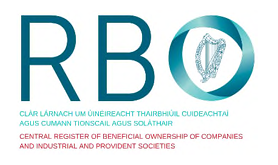
by John McCarthy Consulting Ltd. | Dec 19, 2022 | Blog, News
As many are already aware, access to the RBO Register has recently been shut down, following an EU Court of Justice ruling.
Access to the Register of Beneficial ownership registry is only now being reopened to registered designated persons, which includes accountants in practice.
In order to gain access to the Register from now on, Designated Persons will need to appoint an authorised administrator register themselves, using a Form BEN3A1 Designated Persons Administration Declaration form (fillable online).
We suggest readers monitor the home page of the RBO for more information which will appear there as soon as it becomes available.
Meanwhile, for those of you still in the process of ISQM 1 implementation, please see our new ISQM TOOLKIT or if you prefer to chat through the different audit risks and potential appropriate responses presented by this new standard, please call or e-mail John McCarthy FCA or e-mail him at john@jmcc.ie.
We typically tailor training and brainstorming sessions to suit your firm’s unique requirements.
Publications and AML webinar
To ensure your letters of engagement and similar templates are up to date visit our site here where immediate downloads are available in Word format. A bulk discount is available for orders of five or more items if bought together.

by John McCarthy Consulting Ltd. | Dec 13, 2022 | Blog, News
The ISQM 2 comes into effect on 15 December 2022. It relates to what used to be called ‘engagement quality control reviews’.
These are now called ‘engagement quality reviews’ also known as Engagement Quality Review (EQR or EQ review). These are also referred to as Hot File Review.
The main changes are as follows:
- The standard require the reviewer to challenge the engagement partners’ judgments much more than in the previous requirements. In the past, reviews have sometimes focused on process more than on assessing the quality of judgments.
- The scope of the standard, at least for small and medium firms with non-PIE or listed audits states that reviews should be required:
-
- for ‘other engagements’ that are required by law or regulation; and
- audits and other engagements that the firm itself determines should be reviewed in response to a specific ‘quality risk’.
These types of audit engagement could include those where there are:
-
- high levels of complexity or judgment;
- un-remediated deficiencies in internal control at the audit firm;
- there are recurring inspection findings on the audit; and
- engagements for new clients where there were disagreements with the previous auditor.
Some firms that didn’t need an EQ review in the past may need one in the future as the scope for avoiding one will probably be narrower. However the implications are not clear. It will ultimately depend on individual firms’ assessment of their quality risks and the types of appropriate responses to such risks which may include an EQ review.
Who can carry out the EQR?
Reviewers will need sufficient seniority/experience, with sufficient time and resources allowed to do the job properly.
With ever-increasing emphasis on quality generally within firms and the adverse consequences associated with quality failings, it seems likely that the role of EQ reviewer will be an even more challenging one in future.
As regards documenting Audit Firms’ statement of Quality Management (SoQM), We typically tailor training and brainstorming sessions to suit your firm’s unique requirements.
For more assistance please see our new ISQM TOOLKIT or if you prefer to chat through the different audit risks and potential appropriate responses presented by this new standard, please call or e-mail John McCarthy FCA or e-mail him at john@jmcc.ie
Publications and AML webinar
To ensure your letters of engagement and similar templates are up to date visit our site here where immediate downloads are available in Word format. A bulk discount is available for orders of five or more items if bought together.

by John McCarthy Consulting Ltd. | Dec 6, 2022 | Blog, News
Root cause analysis (RCA) is a requirement of the new ISQM 1 which comes into effect in less than 10 days. It is one of the eight main components of that standard.
Audit firms will be expected to carry out RCA from 15 December 2022 and have the results and implementation action plan available for inspection by audit monitoring teams in 2023.
RCAs main objective is to examine the more serious audit deficiencies that have occurred during either hot or cold file reviews and involves asking ‘why’ questions, typically five times. The ultimate aim being to prevent them from happening again.
Known as the ‘5 Whys’ technique – it is allegedly attributed to the famously successful Toyota vehicle manufacture process.
In the audit world you might find that the source of a problem is lack of adequate staff training or staff performing audit work with an out of date disclosure checklist – the root problem occurs there.
But what is the root cause of the problem? The answer lies in going deeper by asking why the problem occurred. Asking “Why?” five times requires taking the answer to the first why and then asking why that occurs.
Typically, the process of asking “Why?” leads upstream in the process. It may be a defect that occurs in planning, but the root cause may be in the poor quality of client records, or perhaps a lack of sufficiently critical sceptical thinking on the part of the audit team.
Some typical root cause that we have come across include:
- risk assessment at the planning stage of the audit;
- the extent of audit evidence obtained and the level of documentation; and
- the degree of disclosure within the financial statements.
A common reason for these types of issue is a lack of understanding of the ISAs (Ireland) or accounting standards. Some firms insist on staff reading the ISAs as a basic starting point. What a good idea?
The 2022 book of the ISAs (Ireland) is available from the CAI store here. (We promise we don’t get a commission!). These standards are essential reading for all audit teams, especially with so many modifications to the standards coming into play for accounting periods ending 31 December 2022.
Other reasons that can be root causes include:
- flaws in the design of audit tests and
- inadequate review by senior audit team personnel (i.e. the audit manager or the audit engagement partner) as well as;
- Client familiarity which can play a part in leading to poorer quality audit documentation.
For more assistance please see our new ISQM TOOLKIT or if you prefer to chat through the different audit risks and potential appropriate responses presented by this new standard, please call or e-mail John McCarthy FCA or e-mail him at john@jmcc.ie
Publications and AML webinar
To ensure your letters of engagement and similar templates are up to date visit our site here where immediate downloads are available in Word format. A bulk discount is available for orders of five or more items if bought together.

by John McCarthy Consulting Ltd. | Nov 25, 2022 | Blog, News
Continuing our series of blogs where we looked at the scalability of the ISQM(Ireland) 1, this week we look at the question: ‘What are the Main Elements Within a System of Quality Control (SoQM)?
Establishing the SoQM
ISQM 1.6 requires each audit firm to establish and maintain a system of quality control (SoQM) which includes policies and procedures addressing each of the following six processes:
- Governance and leadership;
- Relevant ethical requirements;
- Acceptance and continuance;
- Engagement performance;
- Resources; and
- Information and communication.
There are two other elements of the SoQM that we have covered in our other blogs –
- The risk assessment and responses;
- The monitoring/remediation stage which includes Root Cause Analysis as a key component.
Each audit firm must have written policies and procedures which ensure that its independence and objectivity cannot be jeopardised by the intervention of any partner or member of staff in the carrying out of an audit engagement.
As well as the above policies/procedures, each audit firm must also have:
- Sound administrative and accounting procedures;
- Internal quality control mechanisms;
- Effective procedures for risk assessment; and
- Effective control and safeguard arrangements for information processing
For more assistance please see our new ISQM TOOLKIT or if you prefer to chat through the different audit risks and potential appropriate responses presented by this new standard, please call or e-mail John McCarthy FCA or e-mail him at john@jmcc.ie
Publications and AML webinar
To ensure your letters of engagement and similar templates are up to date visit our site here where immediate downloads are available in Word format. A bulk discount is available for orders of five or more items if bought together.

by John McCarthy Consulting Ltd. | Nov 21, 2022 | Blog, News
Continuing our series of blogs where we last looked at the key differences between ISQM(Ireland) 1 and its predecessor the ISQC 1 establish quality objectives . This week we look at the question: ‘Is the new ISQM 1 scalable?’
Scalability
According to ISQM 1:34D-3 when designing, implementing and operating a system of quality management (SoQM), each audit firm must take into account the nature and circumstances of the firm and its engagements and ensure that its approach is appropriate. In doing this, the firm shall:
- take into consideration the scale and complexity of the firm’s activities; and
- be able to demonstrate to the firm’s regulatory body and to the Irish Audit & Accounting Supervisory Authority, that the policies and procedures are appropriate.
Saleability example:
For firms with low complexity and flat structures, (for example smaller partnerships) objectives about, for example, the firm’s organisational structure and the assignment of roles, responsibilities and authority may not need to contain a lot of detail. Likewise, sole practitioner auditors or firms with only one or two audit staff, objectives relating to HR much are less likely to be very complex.
Another potential factor to take into account is where there are staff working on audits, who have chosen to opt out of the audit exam topic in their professional examinations, this additional risk factor may need to feature in a firm’s risk assessment. Such staff may need additional one-to-one audit training in the auditing basics, as they have not had the benefit of such a foundation to enhance their audit skills and scepticism.
Networks: There are important objectives in the ISQM 1 for firms that are involved in international Networks. Where firms are not members of networks, they don’t need to consider any of the objectives relating to network resources or requirements.
Group audits: Firms that never participate in group audits are unlikely to need objectives surrounding the cooperation with component or group auditors.
Additional objectives
The standard expects the firm’s SoQM to reflect the firm’s nature and circumstances. This means that there could be circumstances where extra objectives will be required in addition to those provided within the standard.
E.g. in a large, complex firm with multiple offices and strategies including mergers and acquisitions, it is likely that the firm may need to expand the mandatory objectives or provide more granular detail in its objectives and risk assessment. Completely new objectives may need to be added in these circumstances.
In smaller, less complex firms it is much less likely to need to expand the mandatory objectives, although additional granular detail may be useful depending on the circumstances.
In subsequent years, firms must take account of feedback from around the firm and from the RCA (Root Cause Analysis) work to mould new or amended objectives, as the entire SoQM is a continuously iterative process.
Where in doubt, external professional expert advice should be sought.
For more assistance please see our new ISQM TOOLKIT or if you prefer to chat through the different audit risks and potential appropriate responses presented by this new standard, please call or e-mail John McCarthy FCA or e-mail him at john@jmcc.ie
Publications and AML webinar
To ensure your letters of engagement and similar templates are up to date visit our site here where immediate downloads are available in Word format. A bulk discount is available for orders of five or more items if bought together.

by John McCarthy Consulting Ltd. | Nov 7, 2022 | Blog, News
ISQM (IRELAND) 1 (hereafter referred to as
ISQM 1) is very different from its predecessor which was called ISQC (IRELAND) 1.
One of the main differences is that ISQC was ‘passive’ (it could sit on the shelf for years without really affecting how the audit work was performed) while the ISQM 1 is much more ‘proactive’ requiring more thought and tailoring in its preparation leading to corrective action like root cause analysis (RCA). More on this in a later blog.
The other key differences are that the ISQM 1:
- Requires the firm to take a risk-based approach to designing, implementing and operating the individual components of the system of quality management (called the SoQM). In this risk based approach firms must:
- establish quality objectives;
- identify and assess the risks (the quality risks) that the quality objectives referred to above might not be achieved;
- design and implement responses to address the quality risks; and
- test and adjust the SoQM on a regular basis (probably annually) to ensure it is always fit for purpose;
- The new ISQM 1 has eight components of a quality management system compared to six in the previous ISQC. The two new elements are
- the firm’s risk assessment process, and
- information and communication;
- The standard includes enhanced requirements related to the firm’s commitment to quality through its culture;
- Greater emphasis is placed on accountability for the system of quality management much more than was the case with the old ISQC;
- There is a much more focused approach to the relevant ethical requirements rather than just independence which was emphasised in ISQC;
- Resources are given more attention, so each audit firm must consider resources such as :
- Human;
- Technological;
- Intellectual; and
- Service providers.
- Communication and information is one of the new components of the quality management system which places more emphasis on communications with external parties;
- There is a new approach to the monitoring process requiring a specific technique called root cause analysis;
- Requirements about engagement quality control reviews (EQCR) or hot file reviews are set out in a new standard, called ISQM 2. The old ISQC dealt with these in the past; and
- There is new requirement to understand quality in relation to:
- resources,
- services and
- monitoring provided by a firm’s network, where relevant.
It’s impossible to cover everything in this brief blog. For more assistance please see our new ISQM TOOLKIT or if you prefer to chat through the different audit risks and potential appropriate responses presented by this new standard, please call or e-mail John McCarthy FCA or e-mail him at john@jmcc.ie
Publications and AML webinar
- The ISQM TOOLKIT 2022 is available to purchase here.
- See our latest Anti-Money Laundering Policies Controls & Procedures Manual (March 2022) – View the Table of Contents click here.
- Also we have an updated AML webinar (March 2022) available here, which accompanies the AML Manual. It explains the current legal AML reporting position for accountancy firms and includes a quiz. Upon completion, you receive a CPD Certificate of attendance in your inbox.
- To ensure your letters of engagement and similar templates are up to date visit our site here where immediate downloads are available in Word format. A bulk discount is available for orders of five or more items if bought together.











